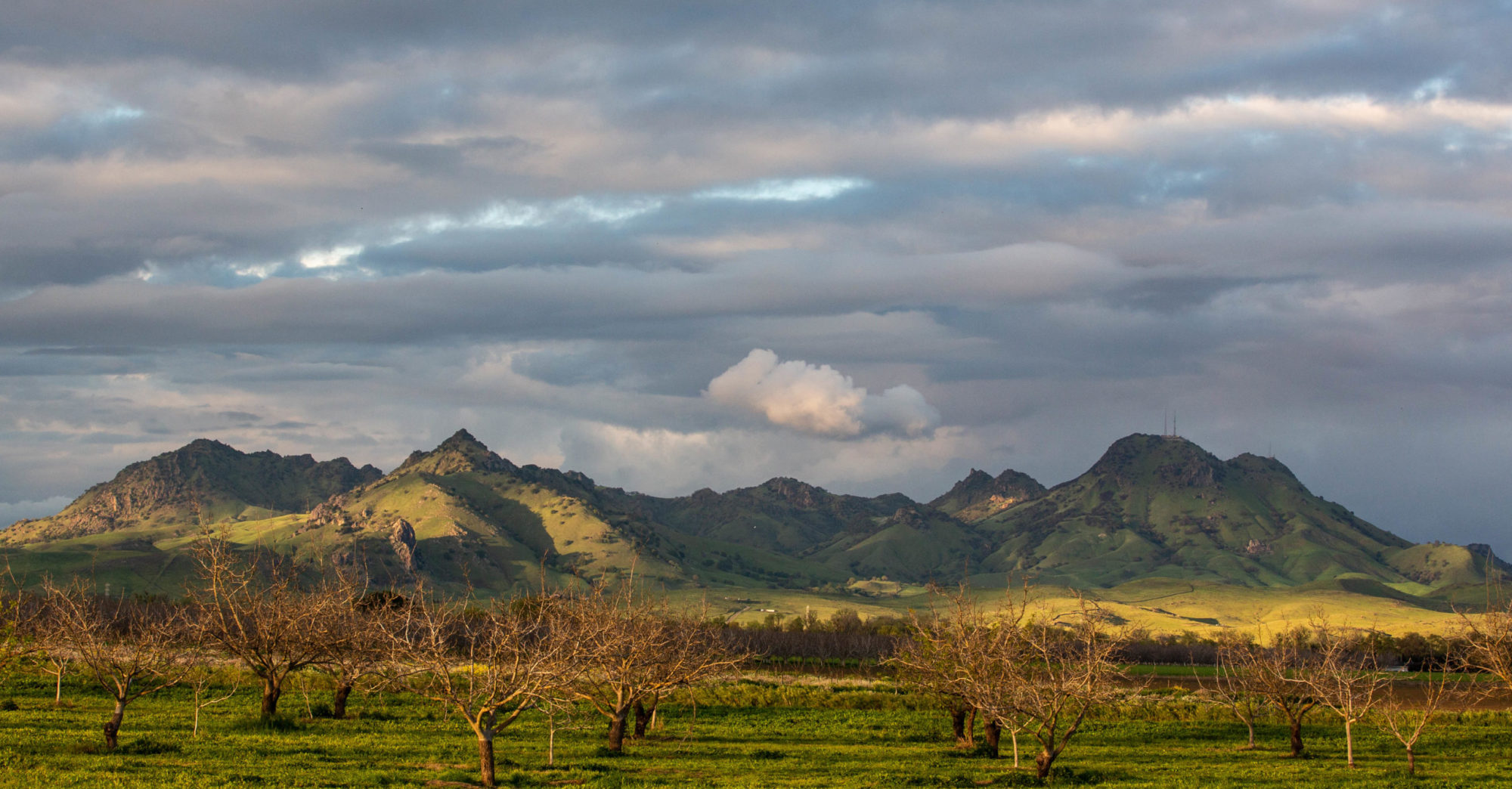Mount Tamalpais from Cesar Chavez Park (also known as Berkeley’s lovely reclaimed old garbarge dump). We wound up there the other night after walking the dog in our neighborhood. It looked like the sunset would be a show, and I said that to Kate when we got home. She said, “Let’s go down to the marina.” It was a great spontaneous moment, and we did it.
Bay, Before the Storm
Nature vs. Nitwit
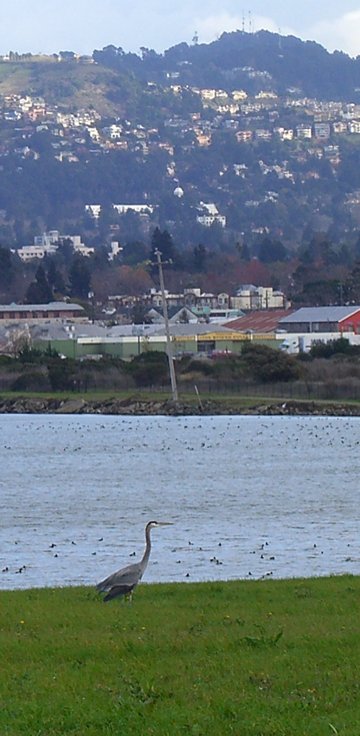
Over the last few weeks, Scout (a.k.a. The Dog) seems to have become obsessed with ground squirrels that apparently infest Chavez Park, the place we take him to run. He’ll stop near a fresh burrow and give it the once over; every once in a while, he’ll dive nose first into one and start digging furiously. So far as we can tell, he’s never come close to catching anything; most of the time I figure the squirrels are looking out from some other entrance to their burrows and having a good laugh.
But maybe not.
The other day, we saw a great blue heron in the meadow we cross on our way to the off-leash area. Scout was so fixated on squirrel world that even when we were within 100 feet of the bird, which stood about 30 or 36 inches tall, he was oblivious to it. We gave it a wide berth, in any case. When we came back about 40 minutes later, it was still there, though it had moved about 100 yards or so across the grass. It wasn’t until I stopped and watched that I realized it, too, was hunting whatever is in those burrows (Scout still was paying no attention, though I put him on the leash so he wouldn’t go charging after the heron once he spotted it). It struck twice while I watched, plunging its beak into the burrow holes, but it came up with nothing.
After a while, a couple stopped and watched what was going on. The guy said he’d seen herons catch squirrels in the field–impale them on their beaks, then sort of toss them up and swallow them. “A couple of times I’ve seen herons out their with their beaks completely red with blood.” I think the herons have a couple advantages over Scout and his like: they’re stealthier, they strike suddenly, and if they hit their target, there’s no fight.
Not sure if the bird above is the same one we saw the other day or not (didn’t have my camera with me then). It was in the same place, anyway (for a local reference in the picture: that big white building that appears above the telephone pole in the middle distance is the Claremont Hotel, which is probably three miles in a straight line from where we were; the high point in the hills beyond is Vollmer Peak Round Top, about 1,900 1,760 feet above sea level and about six eight miles away).
Technorati Tags: berkeley, california
Random Sky Drama
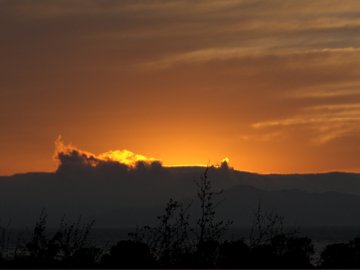
On a walk with the usual suspects in Chavez Park this evening. Above: Clouds running over the ridge between the Marin Headlands and Mount Tamalpais (Angel Island is silhouetted in the middle distance). Below: Mount Tam from the Chavez Park meadow (left) and from one of the trails in the off-leash dog zone (right). Over the past 10 years, we probably went down to this park about once or twice a year; most of my walking and local outdoor recreatin’ has been done in the other direction, up in the hills. Since The Dog arrived among us in May, we’ve probably been down there three or four times a week on average. The view is different every day.
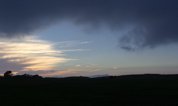
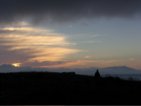
Technorati Tags: berkeley, berkeley photography
Dump
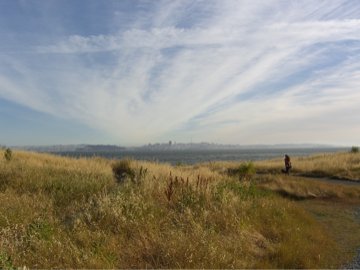
I don’t have the exact statistics at the ready, but something like 35 or 40 percent of San Francisco Bay has been filled since the region was settled in the 19th century. About 95 percent of the wetlands surrounding the bay have been diked, drained and developed. Berkeley’s most visible modern contribution to the great, undeclared bay transformation project is its old garbage dump, part of a complex of old fill projects that stretch more than a mile along the waterfront and extend more than three-quarters of a mile into the water from the old shoreline (which itself is at least one-third of a mile west of where the European interlopers found the water’s edge).
The dump was a great place. Noisy, smelly, full of garbage and construction debris, seagulls and big graders. I worked as a construction laborer for a while after I moved out here, and every once in a while was sent on a dump run to unload a pile of old shingles or lumber or fractured plaster and splintered lath. A cashier took your fee, then sent you on your way, out the potholed road to the mountain of discards. A worker out there directed you to the edge of a live pit, and you added your stuff to all the household garbage, old tires, unwanted furniture, lawn clippings and miscellaneous unidentifiable sweepings from all over the city. I would always feel a little exhilarated to see it all and to throw mine, whatever it was, in on top. The graders and other heavy equipment were constantly at work crushing the trash, packing it down, making room for more; once a pit was full, it would be covered with dirt and the garbage would go to a new one. The old pits would settle over time and be reopened to take on more refuse. This went on for years.
About two decades ago, the dump reached capacity. So much garbage had been packed in that at one point it had been squeezed out in the Bay under the dikes built to contain the fill. The city built a “transfer station,” a big open warehouse-like structure where all the trash would go to be sorted and re-transported, if it wasn’t recyclable or compostable. The old dump was covered with dirt, lots of dirt. Part of it was landscaped and turned into a manicured city park and named after Cesar Chavez, the late farmworkers’ labor leader. Most of the fill was planted with native flora and studded with pipes to vent the methane and other gases from the old buried trash. Roads and trails were built. Part of the semi-wild-looking area at the center of the old dump has been opened up as a park for off-leash canines.
So, at the end of this environmentally unfriendly epic (a story line shared with many great city parks, like Grant Park in Chicago), we’ve got a beautiful piece of waterfront property with staggering views across the bay and back toward the hills, filled with bike riders, hikers, dog-walkers, picnickers and kite-flyers. Our garbage? It’s headed someplace else, where it’s unlikely to grow into something similar.
Technorati Tags: berkeley, california
